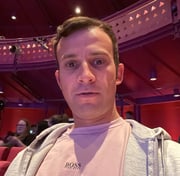Testit 2025 - 25 September
Speakers & sessions

Richard Bradshaw
Senior Architect, Quality Engineering at Slalom Build
Track and time: Track 1 at 8.10
Session type: Keynote
About the speaker:
A true driving force in the software testing and quality domain. I’m a tester, automator, speaker, writer, teacher, strategist, leader, and a friendly human.
Richard Bradshaw is an experienced tester, consultant, trainer and generally a friendly guy. He shares his passion for testing through consulting, training and giving presentations on a variety of topics relating to testing. With over 19 years of testing experience, he has a lot of insights in the world of testing and software development.
Debugging the Past to Engineer the Future – A Quality Revolution
The pace of change in the software industry is relentless. New tools, methodologies, and technologies emerge every week, making it difficult to keep up. For testers and quality engineers, this rapid evolution can feel overwhelming. Just as we adapt to one change or technology, another appears in our feed. With AI, automation, cloud, low-code, no-code, AI agents, and more, it’s easy to feel like we’re in a constant race to stay relevant, or worse, like we’re falling behind.
But is everything we’re seeing truly new? While the landscape we work in continues to change, many of the challenges we face today, or will face in the future have parallels in the past. The core thinking, skills, and principles that have shaped software testing for decades remain critical: risk management, test design, oracles and modelling. Instead of discarding past lessons, skills, and experiences, what if we reshaped them to meet the demands of the future, and make the leap feel less daunting.
In this talk I’m going to share my own journey of getting to grips with the latest technologies, especially AI, and how my past testing skills made the transition easier than expected. For example, writing tasks for AI agents is remarkably similar to writing test cases, the same skills and techniques are at play. Quality engineers and testers are perfectly positioned to thrive with these changes, but we must take lessons from the past, reshape them, and lead a quality revolution to build better software.
Key takeaways:
- Identify key core skills and principles in software testing that remain relevant today.
- Describe how core testing concepts apply to modern technologies like AI and automation.
- Recognise similarities between traditional testing tasks and emerging AI-driven workflows.
- Explain how reflecting on your current testing skills can reduce the learning curve when working with new tools and methodologies.
- Assess your own testing skills and experiences to build confidence when adopting new technologies

Jonas Breisel
Senior software tester at Xplorafory Test AB
Track and time: Track 1 at 9.30
Session type: Presentation
Recommended for:
This session offers valuable insights for any level of knowledge, but it will be most beneficial for testers and managers with around 5 years or more of experience.
About the speaker:
I’m a senior software tester with 14 years of experience helping teams implement smarter, more impactful testing practices. My career has focused on bridging the gap between technical testing processes and strategic business outcomes, resulting in more efficient teams, higher-quality products, and satisfied customers. I have experience speaking at conferences such as SAST Väst in Gothenburg and SAST in Stockholm. I am also the facilitator of Passion For Testing in Gothenburg.
The Future of Test Strategy: A Proven Method for Effective and Adaptive Approaches
As the demands on software testing grow more complex, the need for a robust, adaptable test strategy has never been greater. In this session, I’ll share my unique Q.A.R.E method—Quality, Analysis, Risk, Execute—for creating test strategies that don’t just work—they drive measurable results.
The talk will focus on four core principles:
- Quality: Ensuring the product meets high standards.
- Analysis: Deep understanding of what and how to test.
- Risk: Prioritizing based on impact and probability.
- Execution: Turning the plan into action.
This isn’t just a theoretical session. Attendees will gain actionable tools and frameworks they can adapt to their unique situations, starting immediately. Real-world examples and step-by-step guidance will help managers and testers alike identify where their current strategies fall short and how to transform them into scalable, future-proof solutions.
Whether you’re looking to reduce costs, boost team morale, or strengthen your company’s reputation, this session will provide the practical know-how to make it happen.

Aakanksha Dave
Release and QA Engineer at SilverRail Technologies
Track and time: Track 1 at 10.30
Session type: Presentation
Recommended for:
Software developers, testers, QA leads and release managers
About the speaker:
I bring over 12 years of experience in QA and am still on the path to learning and growing even further. I am passionate about tech and innovation, driven by problem-solving and delivering impactful results. Constantly learning and embracing challenges, I thrive in troubleshooting and adapting to new technologies. I enjoy sharing insights and experiences while continuously growing. A lifelong learner and a firm believer in the power of digital transformation!
Where Quality Meets Delivery: Navigating the Overlap Between QA and Release Lead
At first glance, the roles of a QA Lead and a Release Lead might seem like distinct entities, one focused on ensuring the product works flawlessly and the other on getting it into users’ hands seamlessly. But when you wear both hats, the overlap between the two roles becomes a dynamic dance – one that’s equal parts challenging and rewarding.
Two Roles, One Goal - Both QA and Release Leads are united by a shared purpose: delivering a product that works as intended, on time. The QA Lead ensures every line of code is tested, every bug is squashed, and the product stands up to scrutiny. Meanwhile, the Release Lead takes the baton, orchestrating the final steps to ensure a flawless launch. The intersection? That delicate balance between perfecting quality and meeting deadlines.
The Overlap: Where Roles Blur
-
Testing for Release Confidence: As a QA Lead, you evaluate functionality, performance, and reliability. But as a Release Lead, you must also decide when testing is “enough” to meet delivery goals. Is this the moment to push forward or hold back? Balancing these perspectives is an art.
-
Risk Mitigation: Both roles revolve around identifying risks. QA focuses on defects and technical gaps, while release management identifies risks in deployment timelines or environments. The overlap demands a keen eye to address both types simultaneously without letting one overshadow the other.
-
Stakeholder Communication: Whether you’re reporting on test coverage or communicating release readiness, the core skill is the same: translating technical details into actionable insights for stakeholders. This shared responsibility requires clarity and a knack for storytelling to bridge the gap between development teams and business leaders.
-
Automation Meets Efficiency: Both roles benefit immensely from automation. QA relies on automated testing for faster feedback, while release leads lean on automated pipelines for seamless deployments. The overlap lies in designing processes that ensure testing integrates effortlessly into the release cycle.
-
Ownership of Quality: Ultimately, both roles converge on one critical truth: quality is non-negotiable. The QA mindset drives a commitment to defect-free software, while the Release Lead ensures the final product is stable and user-ready. Together, they uphold the product’s reputation.
The Creative Edge of Overlap - Navigating these overlapping roles requires a shift in perspective – from seeing them as separate functions to embracing their symbiosis. Think of it as being both the architect and the conductor: designing the blueprint for quality while orchestrating the seamless delivery of the final masterpiece. In this overlap lies the opportunity to shape a unique leadership approach. You’re not just ensuring quality or managing releases; you’re creating a unified pipeline where testing and deployment flow seamlessly together. By embracing this overlap, you become a bridge, transforming complex development cycles into smooth, predictable, and high-quality outcomes. The Result? A product that reflects your dual vision – flawless in quality and delivered with precision.
.jpg?width=180&height=180&name=Sharath%20(2).jpg)
Sharath Byregowda
Director, TE at Collibra
About the speaker:
Sharath Byregowda, Director, TE at Collibra, with over two decades of experience in software development leadership and testing. My forte lies in grasping context and crafting bespoke strategies, always striving to improve through learning from both successes and setbacks. I am a firm believer in continuous refinement and experimentation, with agile and lean principles as my guiding stars. I am dedicated to coaching and mentoring, which has helped build strong teams and deliver successful projects. My aim is to foster a culture of learning and drive initiatives, always looking for ways to make a real difference in how we develop software.

Costa Giannakopoulos
Senior Software Engineer at Collibra
About the speaker:
Costa Giannakopoulos is a Senior Software Engineer in Test 2 at Collibra with 14 years of experience in software quality. Specialising in automation, quality coaching, and driving continuous improvement within CI/CD practices, Costa is passionate about building scalable and efficient testing strategies. He has shared insights at events like Test Atelier and LeedsJS, covering topics such as subcutaneous testing and end-to-end test optimisation. Currently, Costa focuses on advancing test automation within modern DevOps pipelines. Outside of work, he enjoys playing 5-a-side football and is building an app to help organise 5-a-side football groups.
TestStorming - a collaborative, energetic and structured approach to Test design
Track and time: Track 2 at 9.30
Session type: Workshop
Recommended:
A basic understanding of different layers of testing such as unit, component, contract, API, e2e, etc. Also, please bring a laptop for hands-on exercises, although if you don’t have one you’ll still be able to participate by sharing.
About the session:
We talk a lot about ‘whole team approach to (agile) testing’ which sounds great but we don’t talk about how to actually do it. How do we make this change happen? What are the steps to take? How many people in the team can actually discuss testing? Design a test? In many teams while somebody may write unit tests and somebody may write an integration test and somebody executes exploratory testing the design of these are not carried out collaboratively. Duplication can occur, testing at the wrong layer and misunderstandings about what is actually tested (and how). With all this testing and mis-testing occurring it can be difficult to pull the team together and focus on powerful, targeted tests with test design input from everybody. In this interactive tutorial you will learn how to have your team brainstorm, challenge and develop test (design) ideas together and work out the most effective testing layer/level at which the test could be implemented. This method has been tried and tested and has been so successful it starts in one team and spreads across the organisation. We’ll do this through various exercises and examples and along the way we’ll share some techniques, war stories and possible bumps you may run into.
Key takeaways:
- Learn techniques and strategies for collaborating on test design - Our interactive tutorial teaches you how to involve everyone on your team in the test design process, resulting in more effective and powerful tests across different layers
- Say goodbye to duplication and misunderstandings leading to more efficient and accurate tests and better coverage.
- Elevate your team's test design skills and more importantly learn how to increase visibility of testing and drive the quality culture in the team

Antonio Segura
Developer @ Knowit Experience
Track and time: Track 3 at 9.30
Session type: Workshop
Recommended for:
Everyone who wants to learn core habits to change the daily tasks and getting more work done
About the speaker:
Antonio Segura is a developer with a background that defies neat labels. He’s been a manager, designer, and architect, so he knows firsthand what it means to juggle multiple roles and responsibilities.
He has taught Getting Things Done workshops at companies like Notar, Antrop, Kreativgruppen, and Challengermode, helping professionals reduce stress and increase productivity. Over the past two years at Knowit, he’s applied GTD to the messy reality of a digital agency, where shifting priorities, tight deadlines and too many open tabs are the norm. His workshops offer practical tools for anyone trying to stay afloat in the flood of emails, meetings and DevOps tickets.
See the big picture, stay on top of the details
This workshop is for those ready to move beyond daily task management into a more structured approach to handling projects and priorities. We’ll start by establishing the core habits of the Getting Things Done methodology. From there, we’ll shift focus to developing a higher level of clarity that connects your day-to-day tasks to your goals.
Our aim is to equip you with the ability to move through your week with a clear sense of what deserves your attention, and the confidence that you’re using your time and resources in the best way. We don’t want you getting sidetracked by vague projects or unclear priorities. To prevent that, we’ll use a bottom-up approach, tracing the tasks currently on your plate to the bigger things they support. We'll also take a top-down approach, reviewing your goals to assess whether your current projects reflect what really matters to you.
This is a hands-on workshop. There’s no group interaction, but you’ll be guided through private exercises and reflections, so bring something to write on.
Key takeaways
- Turn problems and opportunities into projects.
- Keep track of your commitments.
- Maintain a clear overview of your current workload.
- Create a complete inventory of your roles, responsibilities, and priorities.

Kat Obring
Quality leadership coach at Skiller Whale
Track and time: Track 1 at 12.30
Session type: Keynote
Recommended for:
Test managers, test engineers, agile testers
About the speaker:
With over 20 years of experience in the software industry, Kat Obring now focuses on teaching teams and individuals shift-left testing strategies and leveraging DevOps practices to achieve speedy delivery with predictable quality. Experience at companies such as Linden Lab (Second Life), Disney Online, Infinity Works, and Accenture has solidified the belief that most technology challenges are fundamentally people-driven. As a result, Kat prioritises developing processes and cultivating relationships that build high-performing, satisfied teams. Kat emphasises that effective testing is a critical component of quality engineering that accelerates delivery rather than slowing it down.
The Connective Tissue of Tech: Why Glue Work Deserves Your Attention
In the tech world, we celebrate breakthrough features and transformative code. Yet beneath these visible achievements lies a critical but often invisible foundation: glue work. This talk explores how testing, integration and cross-functional coordination serve as the connective tissue that holds our technical organisations together. Drawing from real-world examples and data, I'll examine why this work—typically undervalued and disproportionately shouldered by testers and other perceived non-technical professionals—is essential for sustained organisational success.
Key takeaways
- Why the most crucial work often goes unrecognised in performance reviews and promotion cycles
-
How the invisibility of glue work creates both technical debt and organisational debt
-
The true cost of neglecting integration, testing and cross-team coordination
-
Practical strategies for making glue work visible and valued at all levels
-
Creating career paths that recognise and reward this essential contribution
.jpg?width=180&height=180&name=LindaHoff%20(1).jpg)
Linda Hoff
Senior manager at Qlik
Track and time: Track 1 at 13.15
Session type: Presentation
About the speaker:
Linda has over 20 years of experience in the software industry, predominantly in various leadership roles, including 10 years in people leadership. Her passion lies in team dynamics and successful teams where all team members are happy, maintains a healthy work-life balance, and reaches their highest productivity. Throughout her career Linda has witnessed the evolution from waterfall methodologies, local teams, and full-time office work to continuous deployments to cloud, globally distributed teams, and flexible remote work. Linda is also an experienced speaker, having presented at numerous conferences such as EuroSTAR and Öredev.
Why guts and vulnerability matter in team dynamics
Being vulnerable is not easy. It can be painful and uncomfortable however, after attending this presentation, I hope you will approach the daunting feeling of vulnerability with a fresh perspective. You will learn how to embrace vulnerable while feeling proud and valuing your courage and bravery, just like a superhero.
In this presentation you will discover what makes teams successful and how everyone can contribute to a team dynamic where all team members can thrive and be happy.
Key takeaways:
- Understand what psychological safety, trust and vulnerability is and isn’t.
- Hands-on examples of how you can build and contribute to a successful team.
- How to handle some of the most common challenges.
.jpg?width=180&height=180&name=jimmy_dahlqvist%20(1).jpg)
Jimmy Dahlqvist
AWS Serverless Hero
Track and time: Track 2 at 13.15
Session type: Presentation
About the speaker:
Jimmy is a developer and architect with a great passion for the Cloud in general and AWS in particular.
He has been working in tech since 2003 and transitioned into cloud and AWS in 2015, and has since then been a true AWS-evangelist, leading to him being recognised as AWS Serverless Hero.
His greatest passion lies in serverless technologies, and he love to share his knowledge with others and think it's really rewarding to see people grow. Every moment of his spare time he spend coding and testing new things, blogging about it on Jimmy Dahlqvist - Tech blog by AWS Serverless Hero, Jimmy Dahlqvist. Writing about AWS, cloud, architecture, development, serverless, and everything there is to know about cloud and AWS
He started GitHub - JimmyDqv/serverless-handbook as the home base of all his serverless adventures.
When he’s not writing about serverless, you will find Jimmy talking about his other passions, IoT and BBQ.
Automate. Serverless and event-driven approach to DevOps
In today’s fast-paced development environments, reducing manual tasks is crucial for productivity and developer experience. This talk will explore how a fintech market leader in Sweden, created a serverless and event-driven integration with Slack on AWS. Creating a solution, to automate tasks across a multi-account setup. Learn how this journey optimized cost, enhanced productivity and security by eliminating repetitive tasks, by minimizing human error. A key aspect was integrating alarms and notifications directly into Slack, enabling developers to take immediate action on system alerts. We will look at the problems, deep dive into implementation, and the challenges we faced. Join us to gain valuable insights and practical tips for transforming your workflows. Audience will learn how we integrated our DevOps way of working and tooling with Slack to automate tasks, boosting productivity, creating better developer experience and at the same time reducing cost.
Key takeaways
-
How to automate task to increase developer experience
-
How to create an serverless and event-driven solution across multiple AWS accounts
-
Using automated scheduling to save cost

Johan Hoberg
Associate QA Director at King
Track and time: Track 3 at 13.15
Session type: Presentation
Recommended for:
Software developers, testers, QA leads and release managers
About the speaker:
I am an engineer with a great passion for testing, quality and QA. I started my career with a decade at Sony Mobile, and I am now at my 12th year working with mobile games at King.
Developing high value, complex software efficiently in large, complex organizations fascinates me, as it spans over so many different fields; business, technical challenges, QA & test, processes, management and leadership, organizational theory, team efficiency, culture, tools & automation and many others.
I love thinking, talking and writing about anything related to QA - and if it is not directly related - I always try to find those connections. Almost everything is related to quality in some shape or form, which is why are field is so very interesting.
Quality Intelligence - How test competence adds value throughout the software development life cycle
Testers have a broad set of skills that can be an asset to the team throughout the software development life cycle in many different ways - but we also have a unique core competence that we bring to the table. Solving complex test problems. We need to be able to translate these skills into value for the team - by providing the right quality information to the right stakeholders at the right time in the right format. This is what I call Quality Intelligence.
In this presentation I will walk you through the mindset and principles that guide me in creating QA processes, strategies and frameworks to enable delivery of high quality games/software efficiently.
Key Takeaways
-
Understanding my Quality Intelligence concept, and why I believe that word is a better representation of what we do than the QA acronym
-
The connections between a tester's core competence, complexity, and deep work
-
Reflections on how a tester can add value to a team throughout the development lifecycle

Katjana Brandt
Test manager at ZetaDisplay
Track and time: Track 1 at 15.00
Session type: Presentation
Recommended for:
Anyone - from beginner to expert
About the speaker:
I have worked with test for more than 20 years and within IT since 1998. I’ve worked as a tester, test manager with system tests and acceptance tests, managed test centres and worked with TaaS. Currently I am managing the test team at ZetaDisplay that I built up from scratch. Before that I was a test consultant for 14 years.
Failing with Grace – Learn from your mistakes
I will talk about failing. At conferences people usually talk about how to execute tests in the best way possible, how well a certain project went or how this or that went really well and what the success factors were. But what happens when things go wrong, and you feel all other than successful? I will talk about a project I got kicked out from and what lessons I learned from that experience. I will talk about the project on an overall level, what we accomplished within test, how the project changed over time, what I did, what I achieved and what I could have done better or differently.
Key takeaways:
-
Where is the balance in terms of how hard you can push to get the conditions you need to succeed?
-
Sometimes it might be more important to ”walk the talk” than to actually deliver something.
-
How do you act professionally in a situation where someone tells you that they don’t want you to stay, since they are not satisfied with your work?

Mahasty Assi-Sirhaug
Software consultant at Knowit
Track and time: Track 2 at 15.00
Session type: Workshop
Recommended for:
Software developers and testers, beginner level
About the speaker:
My name is Mahasty Assi, and i have worked at Knowit for almost 7 years now. I started working as a software developer with no specialisation, dabbling in frontend, backend, databases and testing, though i had a soft spot for testing since my university years. After a while i started getting more and more into test development and functional testing, and now QA has become a passion of mine.
WCAG testing
Software that is supposed to be available for the majority of the population is (often) developed by able-bodied, linguistically competent, young-ish groups of people. This leads to unknown biases sneaking into the shaping of said software, and can lead those biases to work against groups of people who might be dependent on the software we create. The Web Content Accessibility guidelines are meant to point out the most common overlooked issues in web development that hinders groups of people to interact with web solutions. In this talk, I demonstrate how to get started with the guidelines, what tools can be helpful to use, and what mindset to have when testing your software for usability issues.
Key takeaways:Meeting the requirements for WCAG standards is not as big
hurdle as one might think, learning to navigate the requirements and being
mindful when you code can easily become a good habit if you know where
to look.

Juho Härme
A software developer at Knowit, Finland
Track and time: Track 3 at 15.00
Session type: Demo
Recommended for:
Software testers, Automation engineers
About the speaker:
Juho Härme is a linguist-turned-software developer with 5 years of practical web dev experience usually with javascript based software stacks and test automation tools like Playwright, Robot framework and Testing library.
Playwright component tests - a sane middle ground?
As new kinds of test automation tools emerge, the traditional classification of automated tests into unit, integration, and end-to-end tests is being challenged, blurring their boundaries. Playwright component tests (CT) provide a way to render UI elements using a real browser but within a limited scope: the tester doesn't have to render the entire UI but can instead choose to render only a
single component or a component within a constrained context. These tests can be particularly useful when full-blown end-to-end (e2e) tests would be overkill, but using a real browser remains a requirement—for example, when testing the rendering
of canvas elements.
In this demo, I showcase real-world applications of CT in different scenarios and compare them to testing with either a more complete UI or a mocked environment like JSDOM. I also address some pain points encountered when using CT in actual projects and discuss whether the approach has been worth the effort. Some alternatives like using Vitest's browser mode are also touched on.
Key takeaways:
Real-world applications of this testing approach, discusses implementation challenges, and considers whether the benefits outweigh the difficulties compared to alternative testing methods.

Anna Björk
Payroll system Tester
Track and time: Track 3 at 15.30
Session type: Presentation
Recommended for:
Managers and other test professionals.
About the speaker:
I have worked with payroll for most of my professional life and mainly on projects to evaluate or/and change payroll system. I often function as a combined project lead and test lead. The last few years I have worked in projects for companies such as Billerud, Samhall, SATS and Akind. From January 2024 I run my own company Lönebruket with three employees (including myself) where we all work in payroll change projects.
Educational testing for your payroll system change
Changing your payroll system is like completing a 10 000 piece puzzle and you are not allowed to fail. This puts a lot of pressure on the testing process. The massive amount of testing required needs not only high skills in payroll but also a great understanding of integrations. This combined skillset rarely exists in companies which means that this needs to be built within the project and therefore the first test phase needs to focus on the education and collaboration of the participants to make the project and payroll system change a successful one.

David Jacoby
Friendly Hacker, Chief Strategy Officer at Syndis and founder at Unbreached
Track and time: Track 1 at 16.00
Session type: Keynote
About the speaker:
David Jacoby is one of Sweden’s most daring ethical hackers and a globally recognized IT security expert with 30+ years of professional hacking under his belt. Known for hacking everything from smart homes to live TV, David makes cybersecurity exciting, practical, and surprisingly human. His talks often blend live demos, sharp insights, and hacker mindset — teaching audiences to break systems only to build them better.
CTRL ALT DEFEND - The Rise of the Ethical Hackers
We often think of hackers as criminals in hoodies — breaking into banks, dodging the FBI, maybe living off energy drinks. And for a long time, that image wasn’t totally wrong — hackers were criminalized, arrested, even turned into urban legends. But today, hacking is an industry, a job title, and in many ways, a mindset. From the 1970s to today, this talk traces how hackers went from outlaws to in-demand problem-solvers. Because in a world built on code, everything — and everyone — needs a little hacker thinking. You don’t need to break the law to break the rules.